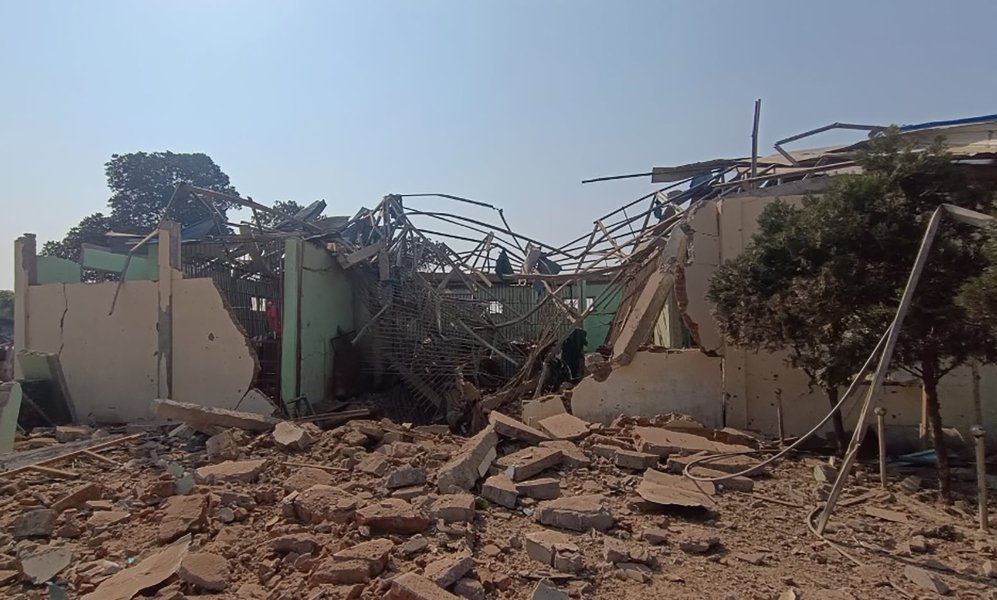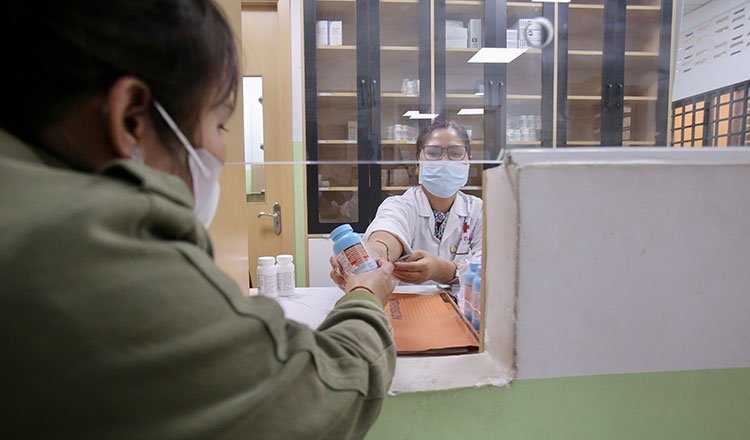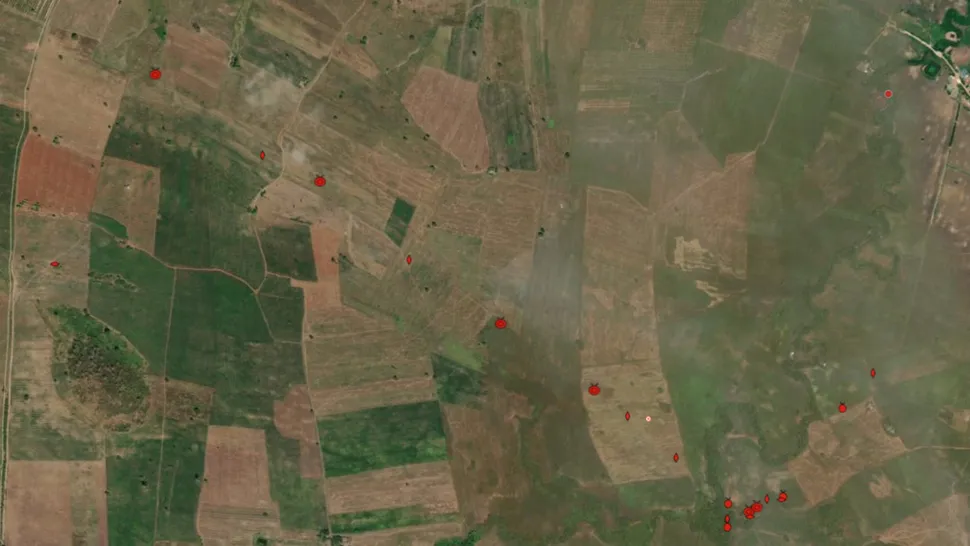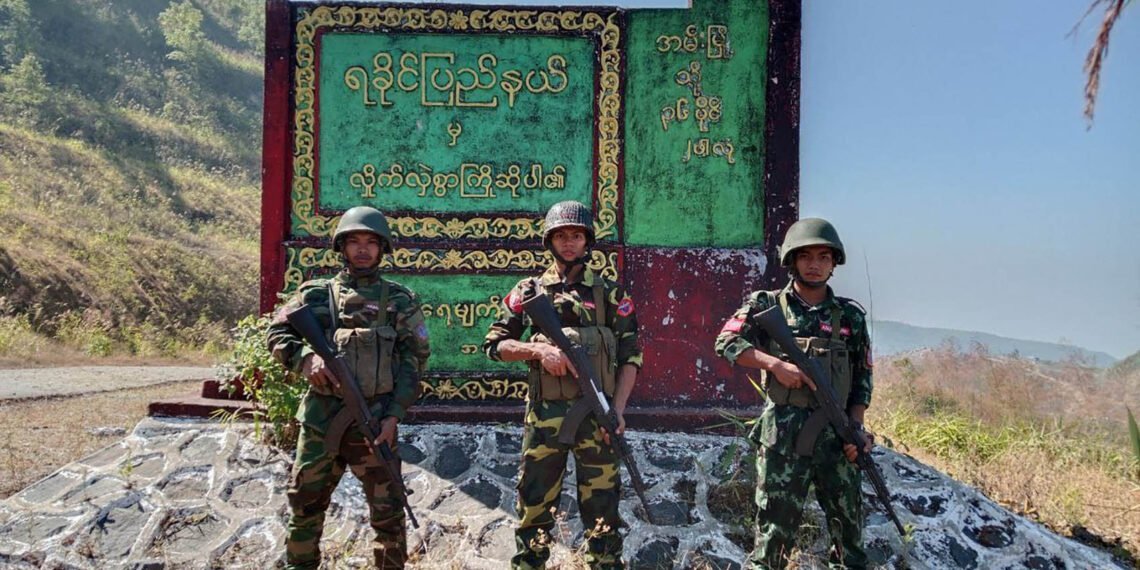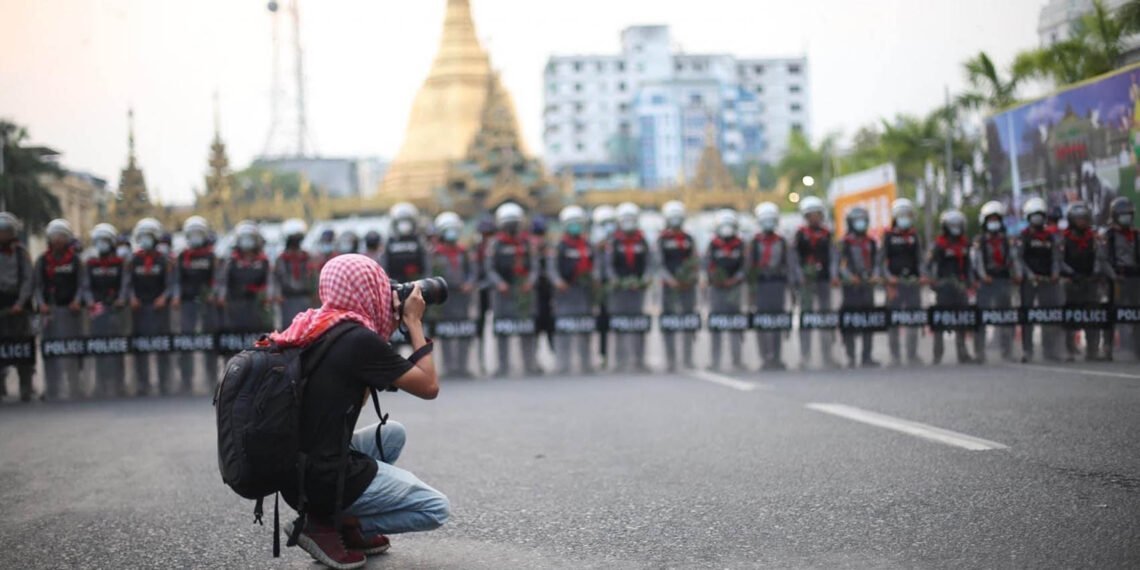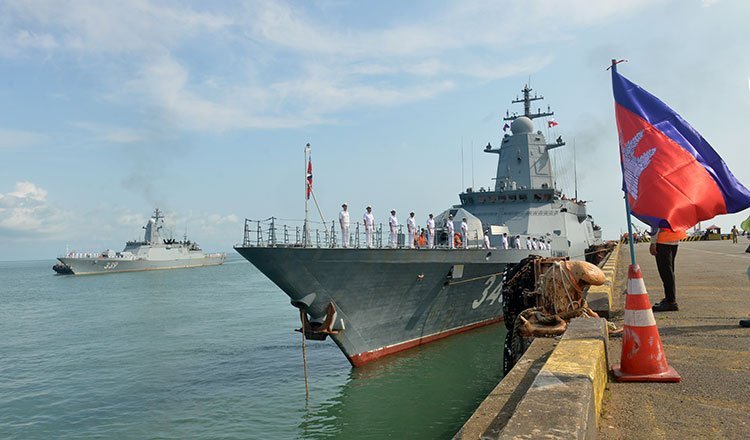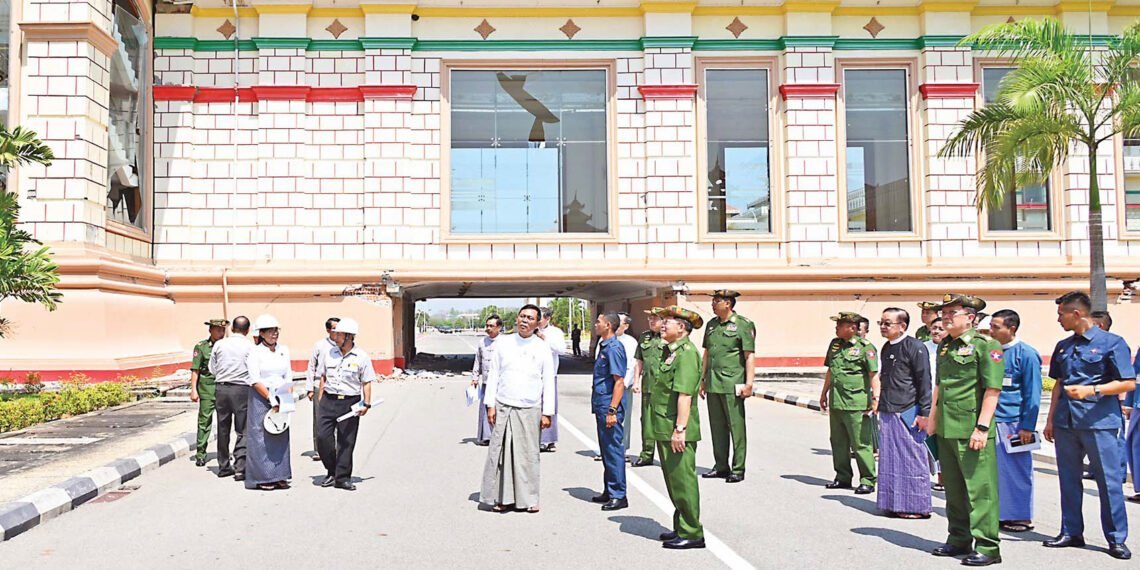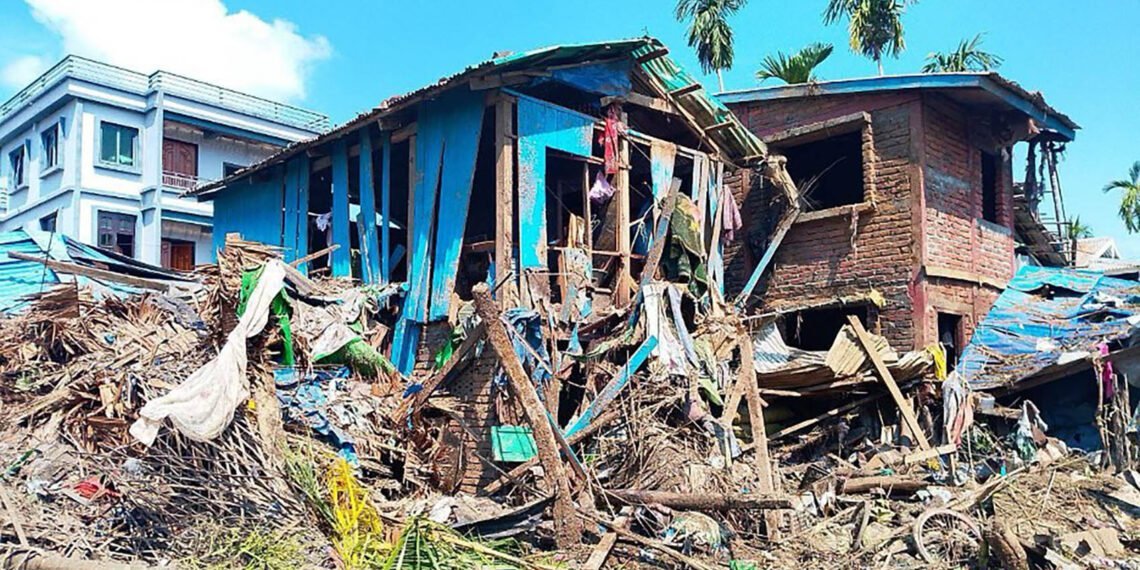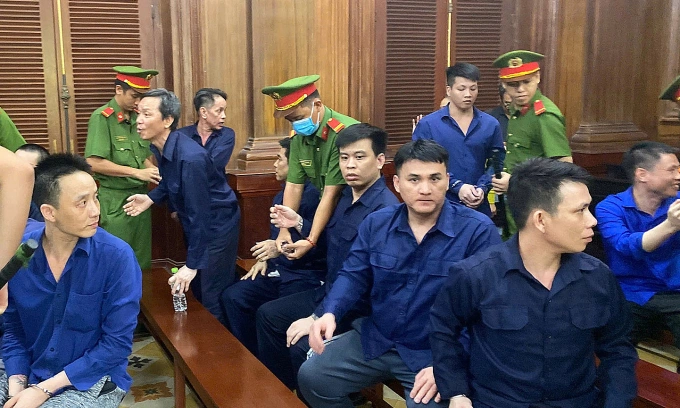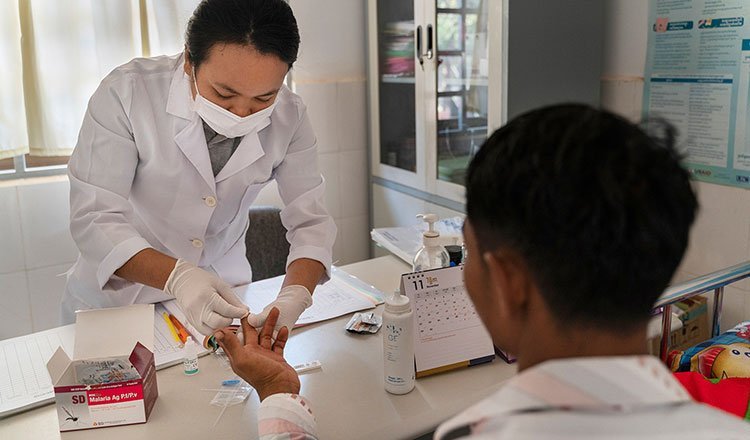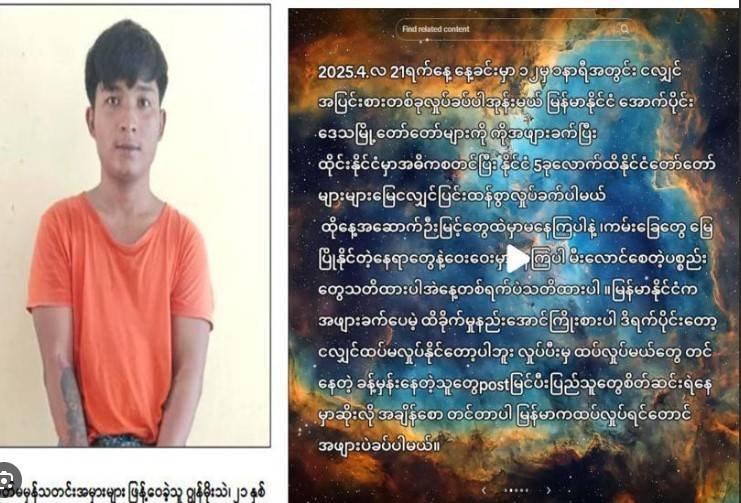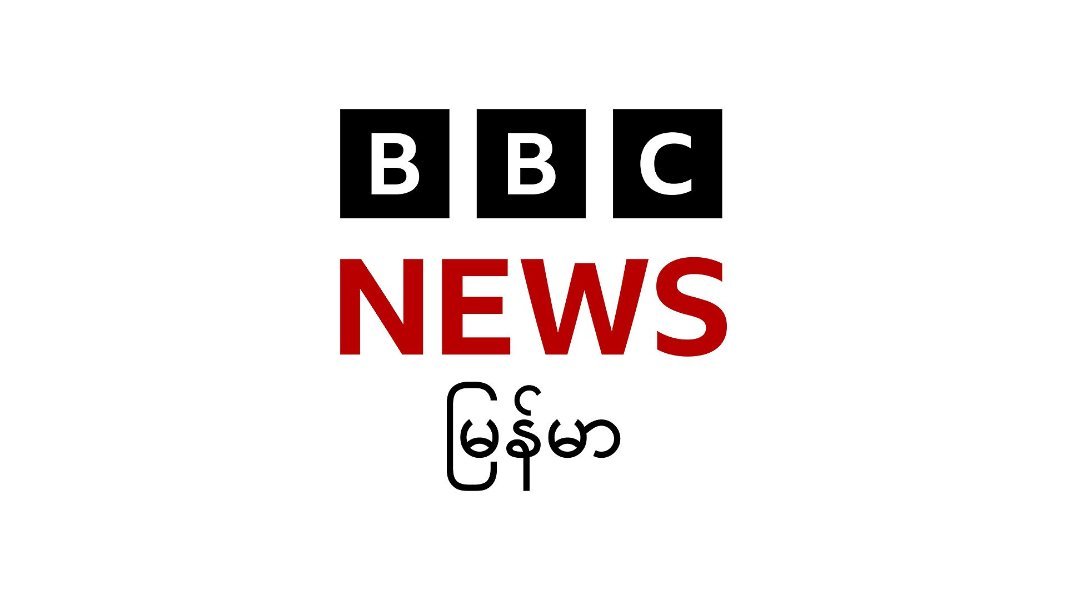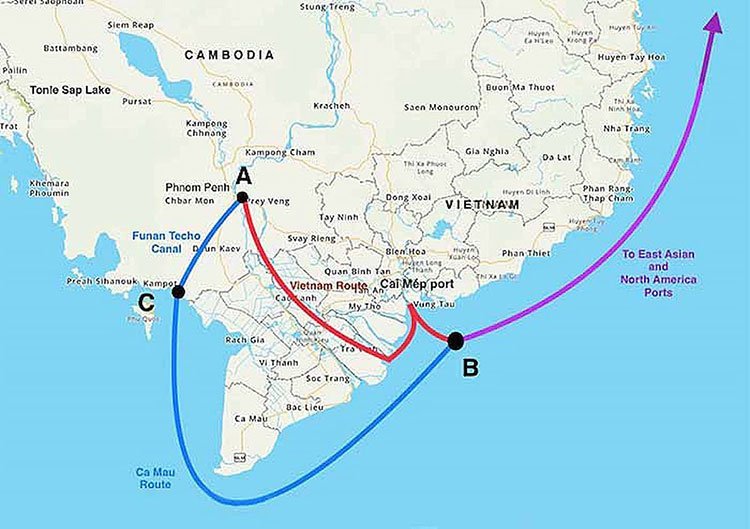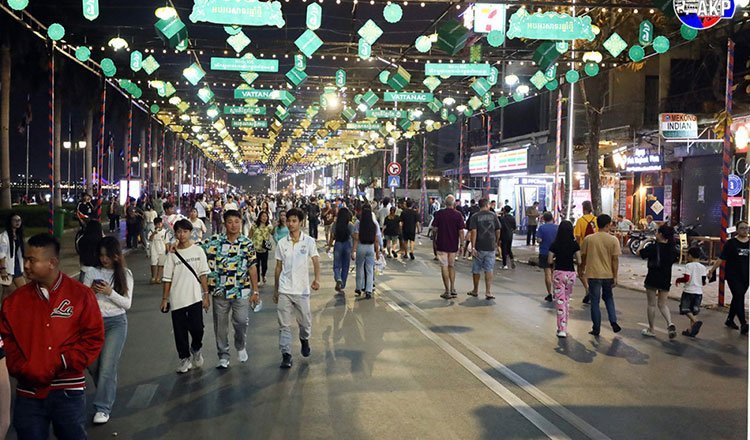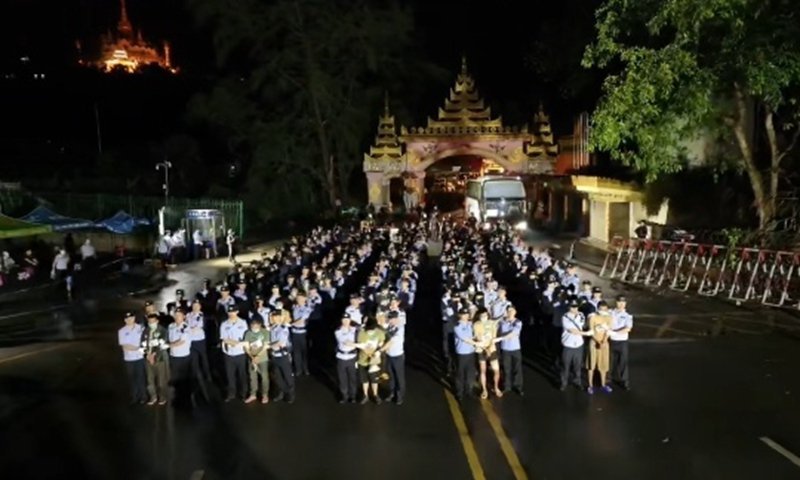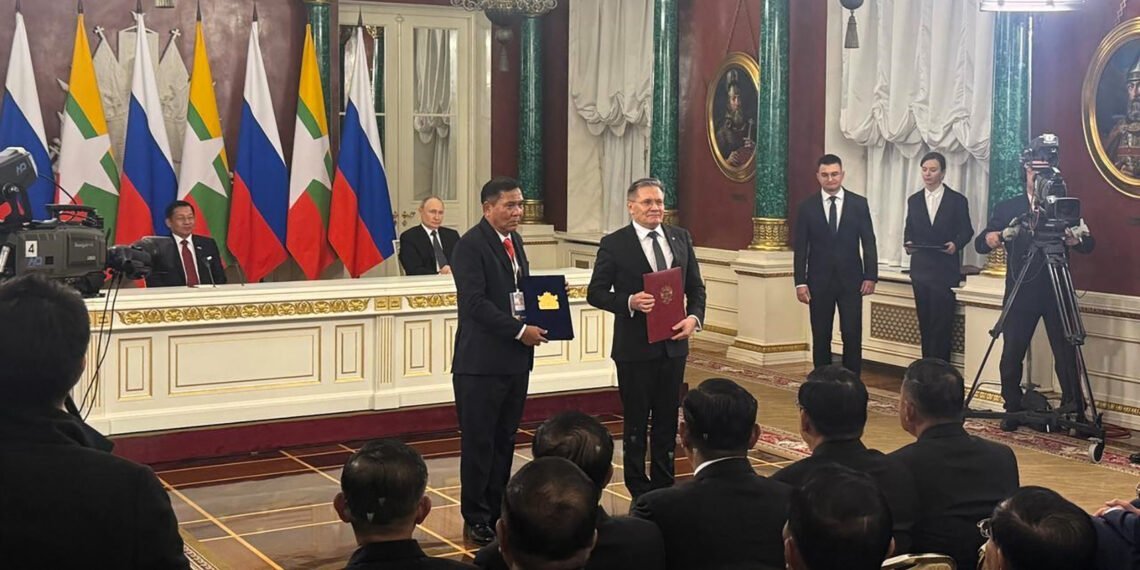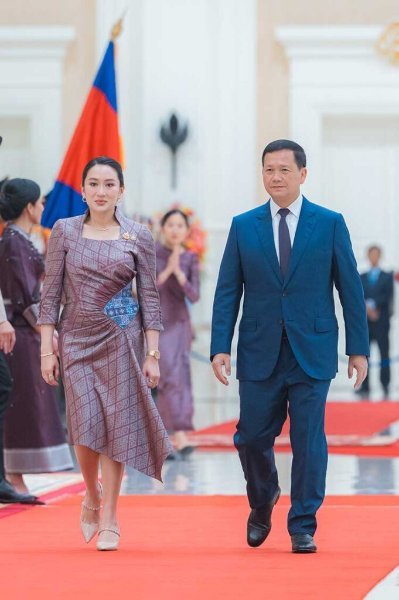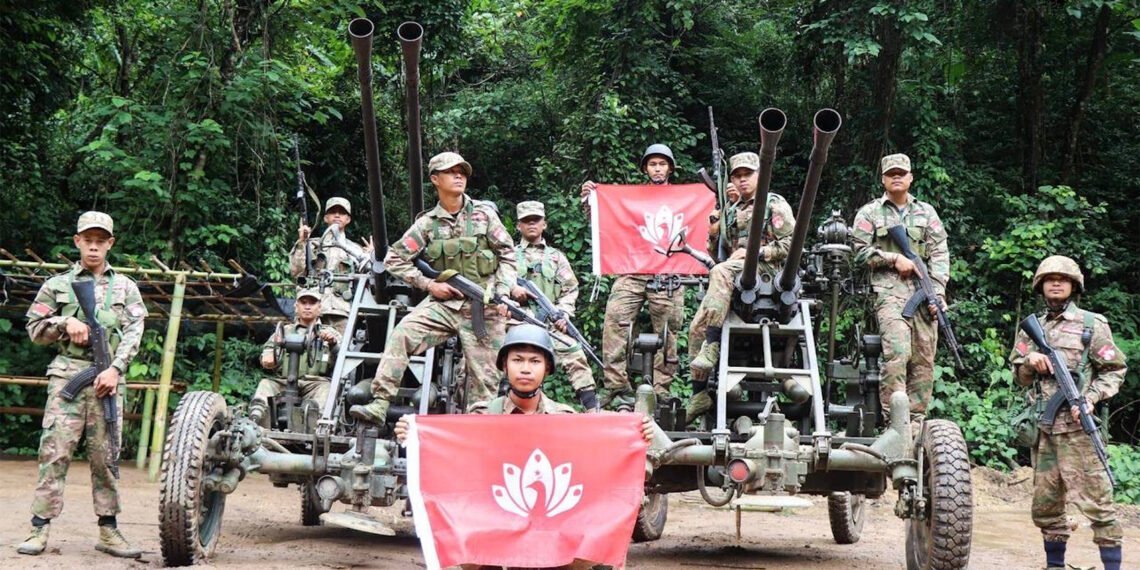-
Posts
15,576 -
Joined
-
Last visited
Content Type
Events
Forums
Downloads
Quizzes
Gallery
Blogs
Everything posted by geovalin
-
CJ Eight civilians have been killed and dozens more injured in a series of junta airstrikes in Myanmar’s Sagaing region, local residents told Radio Free Asia on Wednesday, as the military ramps up assaults despite a declared ceasefire. The weekend bombings targeted six villages in Kale township—Nat Chaung, Nat Myaung, Ngapha, Than Po, Chaung Gwa, and Aung Chan Thar. Among the dead were seven women and one man. At least 28 others were wounded. Sagaing has become the frontline of Myanmar’s resistance movement since the military coup in 2021. The region, also hard-hit by last month’s 7.7 magnitude earthquake, has seen repeated raids, arson attacks, arrests, and now intensified airstrikes from regime forces. According to one resident, who asked to remain anonymous for safety reasons, the death toll could have been even higher. “People had built bomb shelters and defences, which reduced casualties,” he said, though many villagers have now fled and full numbers remain uncertain. All victims were civilians, he added. The attack follows the junta's recent ceasefire deal with the Myanmar National Democratic Alliance Army in Shan state, a move critics say has allowed the military to redirect firepower to other regions—particularly Sagaing and Mandalay. The country’s exiled National Unity Government (NUG) sharply condemned the strategy. “These agreements often mask plans to intensify attacks elsewhere,” said Nay Bone Latt, spokesperson for the NUG Prime Minister’s Office. “Unity among resistance forces is crucial. Fragmentation plays directly into the junta’s hands.” Since the earthquake on 28 March, junta forces have launched 225 airstrikes, with over half taking place in Sagaing and Mandalay, according to NUG data. The bombings have killed 242 people, including 29 children, and injured nearly 400. Despite the military’s formal ceasefire from 2 to 30 April, the violence has only escalated. Attempts to reach junta officials for comment went unanswered. For the people of Sagaing, air raid shelters and uncertainty have become part of daily life—underlining the grim reality of a conflict that shows no sign of slowing. -2025-05-01
- 1 reply
-
- 1
-

-
UNFPA In the aftermath of a deadly earthquake in Myanmar’s Mandalay region, humanitarian workers are risking their safety and navigating treacherous conditions to deliver lifesaving aid to devastated communities. The quake, which struck amid the country’s ongoing political turmoil, has left parts of Mandalay and Sagaing in ruins. Roads are shattered, communication lines broken, and shelters overwhelmed. Against this backdrop, a Rapid Response Team from the UN sexual and reproductive health agency (UNFPA) mobilised within 72 hours, bringing vital supplies to women and girls in the hardest-hit areas. “The situation is dire,” said Thein Zaw Win, UNFPA’s Communications and Advocacy Analyst in Yangon, who travelled to Mandalay to witness the damage firsthand. “Entire buildings collapsed in seconds. People are sleeping in makeshift shelters or on the streets. Many haven’t seen this level of devastation in their lifetimes.” Getting there was no small feat. Washed-out roads, collapsed bridges, and ongoing tremors turned the eight-hour drive into a ten-hour ordeal. And with monsoon rains now setting in, access is becoming even more difficult. UNFPA teams have focused their efforts on delivering dignity kits, hygiene supplies, maternal health support, and protection services for women and girls—many of whom are cut off from medical care and living in fear of gender-based violence. Mental health support is also a key part of the response. Beyond the rubble, another threat looms: dwindling international aid. Global funding shortfalls have left humanitarian agencies stretched thin. “We’re working with limited resources, but the needs are enormous,” said Thein. “People need food, shelter, safety—and they need it now.” Despite the odds, frontline workers remain committed. Their message is clear: Myanmar’s earthquake survivors cannot be forgotten. Aid must reach them—before the rains bring even more devastation. For the women, children, and families caught in this crisis, every bit of support counts. -2025-05-01
-
- 1
-

-

Cambodia Lags Behind ASEAN Neighbours in Healthcare Ranking
geovalin posted a topic in Cambodia News
MoEYS Cambodia has ranked below most of its ASEAN neighbours in the latest Numbeo Healthcare Index, scoring just 50.7 out of 100, sparking renewed calls for investment and reform in the Kingdom’s health sector. The 2025 index, released this week, places Cambodia well behind regional leaders such as Thailand (77.5), Singapore (71.8), and Malaysia (70.3). Even the Philippines, Vietnam, and Indonesia posted stronger scores, highlighting the scale of the gap Cambodia must close. While Cambodia was praised for the friendliness of its healthcare staff and the convenience of clinic locations, it fell short in several critical areas. These included the competency of medical professionals, availability of modern diagnostic equipment, efficiency of treatment, and excessive waiting times. Healthcare consultant B Verghese, formerly with the World Health Organisation in Cambodia, said the country’s rural-urban divide remains a major barrier to progress. “The health infrastructure in rural areas is severely lacking. Bridging that divide will require serious public and private investment,” he told Khmer Times. Professor Tan Kimmeng, a senior healthcare figure and member of the Cambodia Chamber of Commerce, added that infrastructure alone isn’t enough. “Cambodia must also launch strong public health campaigns to combat rising lifestyle diseases like diabetes and kidney failure, particularly among young people.” Despite its low regional ranking, experts noted some encouraging signs. A World Bank public sector specialist pointed to gains driven by the private sector, including rising life expectancy and lower infant mortality. However, these improvements are yet to translate into a healthcare system that rivals the Kingdom’s neighbours. As Taiwan takes the global top spot for the seventh straight year with a score of 86.5, Cambodia’s performance highlights the urgent need for comprehensive health reforms. With demand for quality care rising and non-communicable diseases on the rise, the pressure is mounting. For Cambodia, boosting healthcare could be key not only to improving lives—but to catching up with the rest of the region. -2025-05-01 -
Cambodia has reported a record-breaking year for agricultural exports, with nearly 12 million tons of farm products shipped abroad in 2024, generating a staggering USD 5.2 billion in revenue. The announcement came on 29 April during the launch of a new fertiliser production machine by Has Venture Cambodia. Speaking at the event, Secretary of State for the Ministry of Agriculture, Forestry and Fisheries, H.E. Kong Chanveasna, praised the sector’s strong performance and noted that overall agricultural output reached around 40 million tons for the year. Exports reached 95 global markets, reflecting Cambodia’s growing stature as a major agricultural player. “This demonstrates our farmers’ resilience and the increasing competitiveness of Cambodian produce on the international stage,” said Chanveasna. To sustain this growth, Cambodia imported 960,000 tons of fertiliser and over 70,000 tons of agricultural chemicals in 2024. Currently, 16 companies operate within the local fertiliser market. Among them, Has Venture Cambodia, established in 2019, has emerged as a leader in producing natural fertilisers, employing 45 local workers. The firm currently produces 50,000 tons annually and plans to add another 5,000 tons in capacity with a third production line set for installation by year’s end. Its expansion comes as part of broader government efforts to provide affordable, quality inputs to farmers nationwide. The Ministry reaffirmed its commitment to supporting the agricultural sector, stressing the importance of input security and sustainable farming practices. The ongoing investment in domestic production capabilities marks a step forward in reducing reliance on imports and empowering local farmers. With exports surging and infrastructure expanding, Cambodia’s agricultural future looks increasingly fertile. -2025-05-01
-
wikipedia Myanmar’s military-led government has failed for the fourth time to auction off the lakeside home of ousted leader Aung San Suu Kyi, a property that remains a potent symbol of her pro-democracy struggle. Despite slashing the reserve price to 270 billion kyats (approximately $128 million at official rates, or $62 million on the black market), no buyers came forward at Tuesday’s court-ordered auction in Yangon. The iconic property, where Suu Kyi spent nearly 15 years under house arrest, has long been viewed as a landmark of peaceful resistance. The auction stems from a long-running legal dispute between Suu Kyi and her estranged brother, Aung San Oo, over ownership of the property. The sale was intended to divide the proceeds, but Suu Kyi’s legal team had opposed the court’s order. Opponents of the military regime have condemned the sale attempt, warning potential buyers against taking part in what they see as an extension of the junta’s persecution of Suu Kyi. The home hosted key diplomatic figures including U.S. President Barack Obama and UN Secretary-General Ban Ki-moon, and is considered by many in Myanmar to be of deep national and historical value. The reluctance to bid is not purely symbolic. In today’s volatile Myanmar, purchasing the property could bring unwanted attention. Many wealthy individuals seen as aligned with the military regime have been targeted by pro-democracy resistance forces, who view such deals as complicity with the junta. Several businessmen and officials have been assassinated during the ongoing civil conflict. The villa on Inye Lake was originally gifted to Suu Kyi’s mother, Khin Kyi, widow of independence hero General Aung San, who was assassinated in 1947. Suu Kyi resided there until moving to the capital in 2012 to serve in parliament. She has been imprisoned since the 2021 military coup and has not seen her lawyers since December 2022. With no successful bids, the court is expected to relaunch the auction at a later date, though details remain unclear. -2025-04-30
-
Yaw Mang (possibly also earthquake devastation) Fierce clashes between Myanmar’s military junta and the Karen National Union (KNU) have forced over 4,000 civilians to flee their homes in central Myanmar, despite an officially declared ceasefire. Fighting erupted in Shwegyin township in the Bago region, marking a westward expansion of the conflict previously concentrated in Kayin and Mon states. The Karen National Liberation Army, the armed wing of the KNU, has been resisting military rule since the 2021 coup, with battles intensifying during and after the traditional Thingyan New Year holiday. “There was heavy weapons fire,” one resident told Radio Free Asia, speaking anonymously for safety. “Shrapnel was flying. Residents still can’t re-enter the village.” More than 850 households in Shwegyin have now been displaced, with many villagers fleeing toward Bago and Yangon, seeking safety in remote areas or makeshift shelters. In neighbouring Mone township, junta shelling hit Lay Ein Su village, killing a 70-year-old man, Win Naing, and injuring two others. This attack occurred during what was supposed to be a ceasefire, extended by the junta until 30 April to support post-earthquake recovery following a disaster that claimed over 3,700 lives. Despite the truce, the military has reportedly launched hundreds of assaults in KNU-held areas. The Karen group claims 107 attacks occurred during the initial 20-day ceasefire period alone, killing 20 and wounding 55 civilians. The exiled National Unity Government (NUG) condemned the ongoing violence, reporting over 240 deaths nationwide during the so-called ceasefire. Junta officials have remained silent on the latest allegations. Major General Zaw Min Tun, the regime’s spokesperson, did not respond to requests for comment. As the conflict escalates, thousands are left displaced, cut off from aid, and caught in a cycle of violence with no clear end in sight. Would you like a map showing the affected regions in Myanmar and recent conflict zones? -2025-04-30
-
KT Cambodia has secured a place among the top 10 countries worldwide for its HIV response, successfully suppressing the virus in more than 86% of people living with HIV, according to Senior Minister Ieng Mouly. The announcement came during a health policy meeting in Siem Reap on 29 April, where Minister Mouly, who also heads the National AIDS Authority, praised the country’s sustained progress in the fight against HIV/AIDS. He highlighted a remarkable decline in annual new infections — from around 15,000 in the mid-1990s to just 1,200 last year. “This is a result of decades of commitment and cooperation,” said Mouly, crediting comprehensive testing and treatment programmes that have helped Cambodia meet the UNAIDS 89-98-98 goals: 89% of those with HIV diagnosed, 98% of them receiving treatment, and 98% of those achieving viral suppression. Despite this success, officials warn of looming challenges. Young people aged 15 to 24 are projected to make up half of the 7,200 new HIV infections expected over the next six years. The long-term need for antiretroviral treatment among this group could stretch the country’s health resources. Further complicating matters, international funding is set to decline. The Global Fund to Fight AIDS, Tuberculosis, and Malaria is planning to reduce its support for Cambodia by up to 50% between 2027 and 2029 — a significant drop from current levels. In response, Prime Minister Hun Manet has launched the National Policy to End AIDS and Ensure Programme Sustainability (2023–2028), aiming to cut new HIV infections to fewer than one per day by the end of the policy term. A joint task force of development partners and the Cambodian government also plans to scale up social protections, targeting coverage for people living with HIV to rise from 52% to 95% by 2025, and boosting aid to high-risk groups by 2028. Cambodia’s success story stands as a model in the region, but officials say continued progress will depend on sustained funding, youth engagement, and comprehensive care. Would you like a visual timeline showing Cambodia's HIV milestones and future targets? -2025-04-30
-
Image credit: HALO/Google Maps Declassified US spy satellite photos from the Cold War era are helping humanitarian groups in Cambodia locate deadly land mines buried during decades of brutal conflict. The Cambodian countryside still hides the scars of a long civil war that left the land riddled with explosives. Now, with help from 1970s-era satellite imagery once deemed top secret, de-mining experts are uncovering forgotten danger zones that threaten farmers and villagers to this day. “There were over 50 mine-related accidents last year,” said Tobias Hewitt, Cambodia country director for the HALO Trust, the world’s largest mine clearance NGO. “The number is slowly declining, but the risk remains immense.” Roughly 10 million anti-personnel and anti-vehicle mines were laid during Cambodia’s conflict, which spanned from the late 1960s through to the 1990s. Since then, over 20,000 Cambodians have died, and another 45,000 have been injured in mine-related incidents. Many of these explosives lie in rural areas, concealed by time, vegetation, and shifting populations. To combat this invisible threat, HALO Trust teams have begun using imagery from the US military’s HEXAGON spy satellite programme. These detailed black-and-white photographs—taken on film and dropped back to Earth in capsules—were declassified in 2011. By overlaying them with modern maps, analysts can identify long-lost roads and military routes, prime locations where mines were often planted. “It’s a game-changer,” said Hewitt. “People plough land not knowing it was once a road. The satellite photos show us exactly where to look.” As farming becomes increasingly mechanised in Cambodia, the risk of triggering larger anti-vehicle mines—once safely dormant—is growing. Tractors and heavy equipment can now set off explosives that were buried and forgotten for decades. While the old images are proving invaluable, the clearance process remains painstaking. Every suspected area must be surveyed on foot, often inch by inch. But with this new lens on the past, Cambodia’s decades-long battle against land mines is gaining fresh momentum. More than 1,200 square miles have been cleared so far. With luck—and the help of these unexpected Cold War relics—the country hopes to be mine-free by 2030. -2025-04-30
-
AA Bangladesh has publicly defended its informal communication with Myanmar’s Arakan Army (AA), citing national interest and changing realities along its shared border. Speaking to reporters on Sunday, Foreign Ministry Advisor Touhid Hossain acknowledged that Bangladesh’s 270-kilometre frontier with Myanmar is now entirely controlled by non-state actors. “The central government has no authority there,” he said, adding that some level of engagement with the AA had become a “necessity”. The AA, an ethnic armed group, has seized control of most of Rakhine State and neighbouring Paletwa Township since launching a major offensive against Myanmar’s military regime in late 2023. Its rapid advances, including the capture of Maungdaw Township last December, mean that Bangladesh now faces a fundamentally different border dynamic. Dhaka first admitted to opening lines of communication with the AA late last year. While officials stress that these are unofficial contacts, Hossain was clear: “We must maintain whatever level of engagement is necessary.” The move comes amid longstanding tensions over the Rohingya refugee crisis. More than 700,000 Rohingya Muslims fled into Bangladesh following brutal military crackdowns in 2017, and all attempts at repatriation have since failed. Hossain argued that engagement with the AA could aid in eventually securing their safe return. Pressed on whether such contact risks entangling Bangladesh in Myanmar’s internal affairs, Hossain said bluntly: “The conflict in Myanmar is directly linked to our national interest... we must do whatever is necessary.” Meanwhile, Bangladesh’s interim government, led by Muhammad Yunus, has also agreed to a UN proposal to open a humanitarian assistance channel into conflict-hit Rakhine — a move seen as part of a broader strategy to manage instability on its doorstep. As Myanmar’s civil conflict deepens, Dhaka’s pragmatic approach signals a clear shift: principles of non-interference may be yielding to urgent realities on the ground. -2025-04-29
-
The Irrawaddy Myanmar’s embattled independent media faces a fresh crisis as US funding cuts threaten to silence vital news outlets already battered by military repression. In January, a sweeping executive order signed by former President Donald Trump froze US foreign assistance, abruptly halting an estimated US$268 million in global grants — a move that has rippled into one of Southeast Asia’s most fragile media landscapes. Among the casualties are the US Agency for Global Media services, including Voice of America and Radio Free Asia, long seen as lifelines for news in tightly controlled societies. For Myanmar’s independent journalists, already driven into exile by the 2021 military coup, the cuts are a devastating blow. Media organisations such as The Irrawaddy, Mizzima, and Myanmar Now — which together reach millions — have suffered budget losses of up to 35%, with several outlets already forced to close. The situation is especially dire for ethnic media groups serving communities like the Chin and Karen, who are at risk of losing access to news in their native languages. Without sustained funding, experts warn, Myanmar’s junta could soon monopolise information through its state-backed outlets, further isolating dissenting voices. The Independent Press Council of Myanmar and others have scrambled to provide emergency relief, but with rising costs and shrinking donations, sustaining exiled journalists along the Thai border now demands at least US$29,000 per month — a daunting figure without international intervention. In response, Myanmar’s media community is pivoting towards new funding strategies, from building subscription models to launching crowdfunding efforts. Yet these solutions take time, and many fear they will not bridge the immediate gap left by the withdrawal of US support. The loss of American backing marks a wider retreat from global press freedom efforts, undermining Washington’s credibility at a time when authoritarian regimes are tightening their grip. Without urgent action from new donors, the survival of independent journalism in Myanmar — and elsewhere — hangs precariously in the balance. -2025-04-29
- 1 reply
-
- 1
-

-
Facebook A rare hailstorm swept across parts of Cambodia over the weekend, astonishing residents and sparking lively debate about the kingdom’s changing weather patterns. On 26 April, social media lit up with images and videos as people marvelled at the sight of hailstones bouncing off rooftops and gathering in cupped hands. The spectacle was particularly striking in Siem Reap, where hail fell near the ancient Angkor Wat temple, surprising both locals and tourists alike. Hailstorms are highly unusual in Cambodia’s tropical climate, but meteorologists explained that such phenomena can occasionally occur during the seasonal shift between the dry and wet periods. Fortunately, officials confirmed no major damage or injuries were reported during the storm. Still, the event has reignited concerns about the region’s increasingly erratic weather. Experts warn that Cambodia, like much of South-East Asia, is facing a growing pattern of extreme conditions — from sudden storms to prolonged droughts. While Saturday’s hail was light and harmless, memories of more severe incidents linger. In 2013, a hailstorm caused widespread devastation across several provinces, resulting in fatalities, injuries, and the destruction of hundreds of homes. Cambodia is not alone in witnessing these surprises. Last year, northern Thailand endured a fierce hailstorm, and Singapore suffered property damage from hailstones the size of coins. Malaysia’s Selangor province faced similar chaos in 2022. Meteorologists point to the same basic process behind these dramatic events: powerful updrafts in thunderstorms lift supercooled water droplets high into the atmosphere, where they freeze into layers of ice before falling to earth as hail once they grow too heavy. The weekend's unusual weather mirrors broader regional instability. In neighbouring Thailand, authorities recently issued warnings over severe summer storms, blaming a combination of high-pressure systems and shifting wind patterns. Though Saturday’s hailstorm in Cambodia was short-lived, it served as a striking reminder that the kingdom’s climate is not immune to the sweeping changes affecting the globe — and that more surprises may yet be in store. -2025-04-29
-
KT/Heng Chivoan In a sign of deepening military ties, a Russian Pacific Fleet detachment arrived yesterday at Sihanoukville Autonomous Port for a four-day visit, bolstering relations between Moscow and Phnom Penh. The fleet, led by Captain 1st Rank Alexey Antsiferov, includes two of Russia’s latest Project 20380 corvettes, Rezky and Hero of the Russian Federation Aldar Tsydenzhapov, accompanied by the tanker Pechenga. Around 300 sailors disembarked to a warm welcome from Cambodian defence officials and Russian Ambassador Anatoly Borovik. Ambassador Borovik hailed the arrival as “a momentous event” in a year when Russia commemorates the 80th anniversary of its World War II victory. Speaking aboard the Rezky, he emphasised that the port call underlines Russia’s commitment to strengthening military and diplomatic links with Cambodia. Over the coming days, Russian sailors will tour Phnom Penh, engage in friendly football and volleyball matches with Cambodian navy personnel, and attend receptions hosted by senior Cambodian officials. A highlight will be an official reception aboard the Aldar Tsydenzhapov, attended by national leaders and foreign military attachés. The visit marks 30 years since Russia and Cambodia signed their Joint Declaration on the Bases of Friendly Relations. Ambassador Borovik stressed Moscow’s support for Cambodian sovereignty and criticised Western nations for what he described as selective interpretations of international law. This port call also revives a long tradition: Soviet vessels regularly docked in Cambodia during the late 20th century to aid post-war reconstruction. The most recent Russian navy visit was in November 2023, when the Admiral Panteleyev berthed in Sihanoukville. The timing of this visit is seen as particularly significant, with Cambodia recently launching the modernisation of Ream Naval Base — a development warmly applauded by Russia. Ambassador Borovik hinted that future Russian port calls to Ream could soon be on the horizon, suggesting even closer naval cooperation ahead. The four-day stay concludes with a joint departure ceremony on 1 May, cementing a relationship both sides seem keen to nurture well into the future. -2025-04-29
-
Myanmar’s junta has ordered construction companies to reconnect and assess widespread earthquake damage in the capital Naypyitaw, amid mounting questions over the city’s structural integrity. State-run media reported on Saturday that companies responsible for building Naypyitaw's government offices, staff housing, and key infrastructure must contact the junta’s newly formed Buildings Restoration, Utilisation and New Buildings Construction Supervision Committee. At a meeting on 18 April, junta leader Min Aung Hlaing instructed officials to review whether damaged structures met original construction standards. He also announced plans to redraw Naypyitaw’s layout and demanded new staff housing capable of withstanding earthquakes up to magnitude 8. The call to action follows the devastating 28 March earthquake, which left Naypyitaw with the country’s second-highest death toll after Mandalay. Over 70% of government buildings were reportedly damaged, including the presidential residence, parliamentary complex, and the War Office. Fatalities were heaviest among government employees and their families, as hundreds of staff buildings collapsed. Naypyitaw was built between 2003 and 2005 under former dictator Than Shwe, largely through opaque contracts awarded to regime cronies. The city quickly earned a reputation as the "city of corruption," with allegations of substandard construction and misused funds persisting for years. The parliamentary complex, for instance, was constructed by the Associate of Civil Engineering Construction Group (ACE), owned by former sports minister Tint Hsan. His son, Phyo Ko Ko Tint Hsan, who once chaired the company, was jailed for weapons and drug offences but released shortly after the 2021 coup. Despite the scale of the damage, repair work in many parts of Naypyitaw has yet to begin, further fuelling public anger over the junta’s management of the disaster. -2025-04-28
-
- 1
-

-
CJ Myanmar’s military has carried out more than 400 attacks on Rakhine state despite announcing a ceasefire to aid earthquake recovery, according to the Arakan Army (AA), one of the country's largest ethnic rebel groups. In a statement released Thursday, the AA said junta forces launched 409 assaults — including airstrikes, drone attacks and artillery shelling — across Kyaukpyu, Taungup, Kyauktaw, Sittwe and Pauktaw between 2 and 22 April. The strikes reportedly killed one civilian and injured 28 others, among them five children. The military had pledged a ceasefire following a devastating 7.7-magnitude earthquake that struck Myanmar on 28 March, killing more than 3,700 people. However, reports from civilians and humanitarian groups suggest the junta has blocked aid efforts and used the disaster as a pretext to advance military operations. In Rakhine alone, the AA claims 21 houses, two shops and a religious building were damaged or destroyed in the latest attacks. Nationwide, the exiled National Unity Government says junta forces bombed 12 of Myanmar’s 14 major regions during the so-called ceasefire, leaving over 160 dead and nearly 300 wounded. “The military is using this natural disaster as a political opportunity,” said Moe Htet Nay from independent research group Nyan Lynn Thit Analytica. “They have never had good intentions towards the people.” The Arakan Army, part of a broader insurgent coalition, has captured 14 of Rakhine’s 17 townships since launching its Operation 1027 offensive last year. Meanwhile, civilians caught in the crossfire described the ceasefire as "just a show" when speaking to Radio Free Asia. The junta has extended the ceasefire until 30 April, but many fear that the violence will continue unchecked. Requests for comment from junta officials went unanswered. -2025-04-28
-
Photo by VnExpress/Binh Nguyen Nine people have been sentenced to death in Vietnam for their involvement in a major drug trafficking operation that smuggled 91 kilograms of narcotics from Cambodia. The Ho Chi Minh City People's Court on Saturday found Tran Hoang Tin, 39, guilty of leading the network, which hid drugs inside air purifiers and motorbikes to evade detection. Alongside Tin, La Gia Cuong, 55, and seven other accomplices received death sentences for drug trading offences, with Cuong also convicted of drug storage. According to court records, Tin orchestrated the smuggling operation by liaising with contacts in both Vietnam and Cambodia. In October 2022, he purchased ten packages of drugs concealed within six air purifiers from a supplier in Cambodia. When his intended buyer rejected the drugs for poor quality, Tin sourced a new supply through Cuong, maintaining the practice of using household appliances for concealment. The investigation uncovered a broader web of trafficking activities. Tin also collaborated with Nguyen Van Can, who distributed narcotics across Ho Chi Minh City and Binh Thuan Province. Police arrested Can in April 2023, seizing over 21 kilograms of drugs hidden in vehicles, with further raids uncovering another 30 kilograms. Authorities stated the group smuggled more than 91 kilograms of illegal substances between December 2022 and April 2023, earning Tin illicit profits of around VND1.3 billion (£39,900). Vietnam enforces some of the world’s harshest drug laws, with trafficking as little as 600 grams of heroin or cocaine punishable by death. This latest case highlights the country’s firm stance against narcotics crime, especially cross-border smuggling from Cambodia. -2025-04-28
-
WHO Cambodia is on the cusp of eradicating malaria, with Prime Minister Hun Manet announcing remarkable progress towards the country’s 2025 target. In a statement marking National Malaria Day on Friday, Hun Manet revealed that Cambodia reported just 355 malaria cases in 2024 — a 75% reduction from the previous year. Crucially, the nation has recorded no malaria-related deaths since 2018, and 2024 saw the elimination of local Plasmodium falciparum infections, the deadliest form of the disease. “Cambodia is on the verge of achieving a malaria-free goal by the end of 2025,” the prime minister declared, calling on all partners and agencies to maintain momentum in the final stages of the campaign. The effort has been underpinned by widespread access to accurate diagnostics and effective treatment. Dr Huy Rekol, director of the National Center for Parasitology, Entomology and Malaria Control, credited the use of Artesunate/Mefloquine (ASMQ) therapy, which he described as 100% safe and effective, for Cambodia’s success. “This progress has put Cambodia among the leading nations in eliminating malaria,” Rekol said. Malaria remains a significant threat in forested and mountainous regions, particularly during the rainy season. Health officials continue to urge residents in at-risk areas to sleep under insecticide-treated nets to guard against mosquito bites. Once a major public health challenge, malaria’s retreat marks a major milestone for Cambodia, signalling hope not only for the kingdom but also for broader regional eradication efforts. -2025-04-28
-
Screen capture A popular Myanmar TikTok astrologer has been arrested after his viral prediction of another powerful earthquake triggered widespread panic, weeks after a deadly tremor devastated the country. John Moe The, a 21-year-old with over 300,000 followers on TikTok, posted a video on 9 April claiming a “very strong” quake would strike “every city in Myanmar” within 12 days. The video, viewed more than 3.3 million times, warned residents to flee tall buildings and be prepared to evacuate. The forecast came just weeks after a 7.7-magnitude earthquake struck central Myanmar, killing over 3,700 people and displacing tens of thousands. With aftershocks still rattling the region, Moe The’s prediction stoked fresh fear in an already traumatised population. Myanmar’s military authorities confirmed on Thursday that Moe The was arrested during a morning raid in the city of Monywa earlier this week. In a statement published in state media, the government accused him of spreading fake news and pledged to take action against anyone “who writes or shares” such information. "Action will be taken effectively according to the law," the statement said. Though some dismissed the astrologer’s forecast, others took it seriously. “Most of my neighbours dared not to stay in their apartments and lived out on the street on that day,” said Yangon resident Nan Nan. “My friend even hired a small house outside the city in preparation.” Moe The, who posts under the name “John (Palmistry),” regularly shares astrological predictions over cosmic imagery. His claims have included weather disasters, the return of Aung San Suu Kyi, and US airstrikes on Myanmar—none of which have come to pass. Despite the popularity of fortune-telling in Myanmar, experts have firmly rejected the idea that earthquakes can be predicted. “Neither the USGS nor any other scientists have ever predicted a major earthquake,” reads a statement from the United States Geological Survey. “We do not know how.” In a country already battling civil war, a natural disaster, and fragile infrastructure, the spread of misinformation has only heightened tensions. Relief efforts remain hampered by damaged roads and ongoing conflict, with more than 60,000 people still living in makeshift camps. The incident underscores how misinformation on social media can have real-world consequences—especially in regions where official communication is limited, and trust in state institutions is low. -2025-04-25
-
- 1
-

-
The BBC has stepped in to fill a critical news void in Myanmar, launching a satellite channel in Burmese following the collapse of US-backed broadcasts and a devastating earthquake. The new BBC News Burmese channel, to be delivered via the Thaicom 6 satellite, comes just weeks after Donald Trump’s administration abruptly ended funding for Voice of America (VOA), silencing one of Myanmar’s few remaining independent news sources. The BBC will now take over VOA’s former satellite slot to reach audiences left cut off during a time of crisis. The move follows a catastrophic 7.7-magnitude earthquake near Mandalay in March that killed over 3,000 people. In the days that followed, digital traffic to the BBC’s Burmese service surged, highlighting the desperate demand for reliable information. “In Myanmar, where press freedom is severely restricted and a brutal conflict rages, we now have an audience also devastated by natural disaster,” said Jonathan Munro, deputy chief executive of BBC News. “This service will offer vital, trusted reporting to those trying to rebuild their lives.” The new channel will feature BBC television, radio, and digital content in Burmese, and provide QR code access to its wider online coverage. It’s aimed at a population that has long relied on foreign broadcasters to access independent journalism amid increasing state censorship. VOA, historically one of the world’s most prominent public service broadcasters, ceased its Myanmar satellite transmissions just before the quake. The Trump administration has accused it of spreading “radical propaganda,” despite its legacy of countering authoritarian disinformation since World War II. Although a US judge has since ordered funding to be restored, its long-term future remains uncertain. The BBC’s intervention underscores growing concerns over access to impartial news in one of the world’s least free media environments—Myanmar ranks 171st out of 180 countries for press freedom. Former VOA contributor Sithu Aung Myint is currently serving a 12-year sentence under charges of “anti-state” reporting. While the BBC’s move is widely welcomed, it comes at a cost. The World Service, already under financial strain since the Foreign Office stopped funding it in 2014, now faces fresh pressure to sustain its global reach with dwindling resources. Nonetheless, for thousands in Myanmar reeling from tragedy and isolation, the BBC’s return to satellite broadcasting offers a rare and urgently needed lifeline of truth. -2025-04-25
-
A newly signed deal between Cambodia and China to build a $1.7 billion canal has drawn sharp questions from regional stakeholders, amid fears over its potential impact on the fragile Mekong Delta ecosystem. The Funan Techo Canal, backed by Chinese state giant CCCC with a 49% stake, is set to stretch 180 km from the Mekong Basin to Cambodia’s southern coast. Promoted as a boost for irrigation and economic development, the project has faced scrutiny over environmental risks—particularly from Vietnam, whose rice-growing delta lies downstream. Despite the scale and geopolitical weight of the project, Cambodia has so far only provided “basic information,” according to the Mekong River Commission (MRC), which oversees sustainable development of the transnational river. The Commission is now urging Phnom Penh to release full feasibility and impact studies to ensure broader basin concerns are addressed. Environmentalists and experts warn that diverting water from the Mekong could worsen drought and salinity in Vietnam’s delta, already suffering from upstream dam activity. The Delta is not only a vital ecological zone but also a cornerstone of Vietnam’s rice exports. Cambodia insists the canal complies with the 1995 Mekong Agreement, but the MRC says the legality depends on whether the canal directly affects the river’s mainstream flow. “Guidance has been offered,” the Commission said, calling for further transparency from all parties. China’s role in the project, formally confirmed during President Xi Jinping’s recent visit to Cambodia, signals a deeper geopolitical footprint in Southeast Asia’s water infrastructure. Although Xi made no public mention of the canal, a joint communique cited Chinese support based on “feasibility and sustainability.” The canal’s scope appears to have shifted from its original navigation-focused design to one prioritising irrigation. Experts like Brian Eyler of the Stimson Center warn that the volume of water diverted may now be “much more than previously described.” As construction plans advance, the absence of clear environmental data and regional dialogue risks turning a national infrastructure project into a flashpoint for cross-border tensions. The coming months will be critical in determining whether the canal becomes a model of cooperation—or controversy. -2025-04-25
-
AKP Phnom Penh has earned a global spotlight, ranked second among the World’s Best Nightlife Cities by travel platform VISA2FLY—placing the Cambodian capital ahead of renowned party hotspots like Ibiza, Berlin, and New York. The city was praised for its eclectic nightlife scene that blends traditional Cambodian charm with modern flair. From riverside lounges and rooftop bars to hidden speakeasies and thumping nightclubs, Phnom Penh was hailed as “affordable, diverse, and electric,” making it a haven for both budget travellers and seasoned partygoers. “Cambodia’s nightlife is simply a perfect mesh of cultural warmth and modernity,” the report noted. It also contrasted Phnom Penh’s lively club culture with the more laid-back riverside vibe of Siem Reap, showcasing the country’s broad appeal. Bangkok claimed the top spot, while Phnom Penh’s regional neighbours Bali, Ho Chi Minh City, and Dubai rounded out the top five. The Ministry of Tourism attributed the city’s rising nightlife profile in part to the success of initiatives like Chaktomuk Walk Street, a recently launched pedestrian zone near the riverside that’s become a weekend nightlife hub. Officials say the international recognition is more than a popularity contest—it’s a sign of Cambodia’s growing stature on the global tourism map. With its mix of culture, cuisine, and after-dark energy, Phnom Penh is no longer just a stopover—it’s a destination in its own right. As international borders continue to ease and travel rebounds, Cambodia’s capital seems ready to dance well into the global limelight. -2025-204-25
-
CCTV Myanmar has transferred more than 920 Chinese nationals accused of telecom fraud to Chinese authorities, as part of a sweeping joint crackdown on cross-border scams, China’s Ministry of Public Security (MPS) confirmed on Wednesday. The suspects, apprehended in recent raids across southern Shan State, including in Tangyan and Mong Hsu, were handed over at the Daluo border checkpoint in Yunnan Province. The operation represents a significant escalation in efforts by both nations to target increasingly elusive telecom fraud networks operating deep within Myanmar’s territory. This latest handover follows the reported dismantling of large-scale scam operations near the China-Myanmar border. Yet, authorities say many fraudsters have since moved further into Myanmar, setting up new “fraud dens” to avoid detection while continuing to target Chinese victims. Since March 24, Myanmar has conducted several intensive raids with Chinese support, seizing thousands of devices used in scams—including computers, phones, bank cards, and detailed fraud scripts. According to Chinese officials, the cooperation between both countries has so far led to the arrest of over 55,000 suspects connected to these crimes. “The message is clear,” a spokesperson for the MPS said. “No fraud criminal, no matter where they hide, is beyond the reach of the law.” The ministry added that local Chinese authorities have been instructed to carry out full investigations, and urged suspects still at large to surrender in exchange for possible leniency. Beijing and Naypyitaw have pledged to maintain “persistent pressure” on these criminal syndicates, which have flourished in Myanmar’s conflict-affected regions amid weak governance and law enforcement gaps. While the crackdown has been praised by Chinese officials, rights groups and regional analysts remain wary of the opaque legal processes involved and the fate of those detained. Nonetheless, the sheer scale of arrests signals that telecom fraud is now seen as a top-tier security threat by both governments. With joint enforcement tightening, China is sending a blunt warning to fraud networks: relocation offers no refuge. -2025-04-24
-
- 1
-

-

Russia Backs Myanmar Nuclear Plant Despite Quake Devastation
geovalin posted a topic in Myanmar News
Rosatom Russia’s state nuclear agency Rosatom has confirmed it will move forward with plans to build Myanmar’s first nuclear power plant, even as Naypyitaw grapples with the aftermath of a deadly earthquake that left much of the capital in ruins. “The recent earthquake has not affected Rosatom’s plans in Myanmar,” the company stated this week, insisting its reactor designs meet stringent international standards, including seismic resistance. The announcement follows a high-level agreement between junta chief Min Aung Hlaing and Russian President Vladimir Putin during the Myanmar leader’s visit to Moscow in March. The deal formalised a years-long ambition to establish nuclear power in the country, despite deepening political instability and widespread opposition at home. Rosatom’s Director General Alexey Likhachev confirmed the reactor would be located near Naypyitaw, the city worst hit by the 7.7-magnitude quake on 28 March. The disaster, which struck just three weeks after Min Aung Hlaing returned from Russia, killed over 3,700 people—many in the capital—and levelled key government buildings, including the presidential residence and parliament. With much of Naypyitaw in ruins and ministries considering relocation to Yangon, the junta’s focus on nuclear expansion has raised eyebrows. Soil testing for reconstruction is already underway, yet details of the nuclear project remain tightly guarded, including timelines and safety protocols. Local fears are mounting over the wisdom of installing a nuclear facility in a seismic zone. The government’s assurances that the plant will serve only peaceful purposes have been met with scepticism, particularly in light of the military’s continued attacks on resistance-held areas and its poor disaster response record following Cyclone Mocha and recent floods. Observers warn that the nuclear project could exacerbate public distrust and stoke fears over potential militarisation. The regime has long harboured nuclear ambitions, dating back to the era of former dictator Than Shwe, and now faces accusations of prioritising power projection over public welfare. With much of the country in conflict and civilian casualties mounting from junta airstrikes, critics say the timing—and location—of the nuclear plan couldn’t be more perilous. -2025-04-24 -
Facebook collected by Phnom Penh Post Nearly 100 Cambodian women trafficked to China have been rescued and returned home since the start of 2025, shedding new light on the persistent threat of human trafficking across Asia and prompting renewed calls for vigilance. In an update issued on April 22, Cambodia’s General Department of Immigration (GDI) confirmed that 98 citizens—97 of them women and girls—have been repatriated from China in 42 separate trafficking cases this year. Of those, 59 have been reunited with their families, while 39 remain under state care for further support and reintegration. The news underscores the scale and complexity of the trafficking crisis affecting vulnerable Cambodians, particularly women lured abroad under false promises of marriage or employment. Many victims fall prey to transnational criminal networks exploiting legal migration routes. The GDI also addressed rising concerns online, rejecting claims that immigration officials were unlawfully preventing women from travelling abroad. Officials insisted that while Cambodia upholds citizens’ freedom to travel, steps are being taken to identify potential trafficking victims before departure—especially in cases involving young women heading to China. Authorities said that from January to April, 107 people—82 of them women—were stopped at border checkpoints on suspicion of trafficking involvement. The vast majority were Cambodian. At Phnom Penh International Airport alone, 75 individuals were intercepted in 36 separate cases. “Interviewing and prohibiting certain Cambodian citizens, especially women marrying foreigners or intending to work abroad, is not about restricting their freedom,” the department said in a statement. “These measures aim to protect citizens from being deceived and exploited by traffickers.” The statement urged citizens to remain vigilant against recruitment scams and illicit brokers who prey on economic desperation, especially among young women in rural areas. The government continues to crack down on such schemes, though campaigners argue more regional cooperation and legal protections are urgently needed. While the latest repatriations offer a measure of relief, the underlying conditions that fuel trafficking—including poverty, lack of opportunity, and weak cross-border enforcement—remain a serious concern for Cambodian authorities and rights groups alike. -2025-04-24
-
Thailand’s Prime Minister Paetongtarn Shinawatra arrived in Phnom Penh on Wednesday for a landmark two-day official visit aimed at strengthening bilateral cooperation, even as human rights groups raised concerns about the treatment of political dissidents in the region. Welcomed at the airport by Cambodian officials including Commerce Minister Cham Nimul, Shinawatra, joined by her husband Pitaka Suksawat, began a tightly scheduled programme that includes a Royal Audience with King Norodom Sihamoni and meetings with top Cambodian leaders such as former Prime Minister Hun Sen and National Assembly President Khuon Sudary. Central to the visit is a high-level meeting with Prime Minister Hun Manet, during which the two leaders signed several agreements on workforce development, road infrastructure, cross-border bridges, and pollution control. The event coincides with the 75th anniversary of diplomatic relations between the neighbouring countries, marking a period of intensified cooperation. Despite warm displays of diplomacy, the visit is shadowed by mounting international scrutiny. Human Rights Watch has accused both governments of engaging in what it terms a “swap mart”—reciprocal efforts to silence political opponents through deportations, disappearances, and harassment. The group called on Prime Minister Shinawatra to press her Cambodian counterparts to end such practices and uphold human rights protections. In a joint press conference, Hun Manet thanked Thailand for not allowing dissidents to use its territory to interfere in Cambodian affairs, pledging a reciprocal stance. His remarks, however, have drawn criticism amid accusations that both nations are complicit in suppressing political opposition, often in defiance of international legal standards. Incidents such as the 2020 disappearance of Thai activist Wanchalearm Satsaksit in Phnom Penh and the unresolved killing of Cambodian opposition figure Lim Kimya in Bangkok earlier this year have underscored these concerns. While the agreements signed this week may signal a deepening of state-level collaboration, rights groups argue that true progress will require a commitment to justice and transparency—an element that remains elusive in current cross-border relations. -2025-04-24
-
MDY-PDF Myanmar’s military regime has extended a fragile ceasefire until 30 April to allow relief efforts to continue following last month’s devastating earthquake, state media announced on Tuesday. The move comes after a 7.7 magnitude quake struck near Mandalay on 1 April, killing more than 3,700 people and flattening entire communities in one of Southeast Asia’s poorest countries. The disaster has compounded the nation’s already dire humanitarian crisis, with much of the infrastructure damaged and access to aid limited by ongoing conflict. Junta leader Min Aung Hlaing initially called a 20-day ceasefire earlier this month “out of sympathy and understanding for the people affected,” according to state broadcasts. The extension is meant to facilitate rescue, rebuilding, and aid delivery in quake-hit regions. Despite the truce, reports from the United Nations and humanitarian organisations suggest that military activity has continued in parts of the country, including airstrikes. This has raised concerns over the sincerity of the ceasefire and its effectiveness on the ground. Myanmar has been in turmoil since the 2021 coup that ousted Aung San Suu Kyi’s elected government, triggering nationwide protests that evolved into a broad armed resistance. The conflict has displaced over two million people and left vast areas of the country inaccessible to international aid. The ceasefire extension follows rare talks held last week between Malaysia’s Prime Minister Anwar Ibrahim, junta officials, and a major resistance group. As current chair of ASEAN, Anwar has pushed for humanitarian access and dialogue, though the bloc has struggled to make meaningful inroads in resolving the crisis. As relief teams race to assist survivors in Mandalay and surrounding areas, aid workers continue to call for unrestricted access and a genuine commitment to peace. While the junta’s gesture may signal a temporary easing of tensions, many fear it could be short-lived—another pause in a war that has devastated lives and tested the limits of regional diplomacy. -2025-04-23


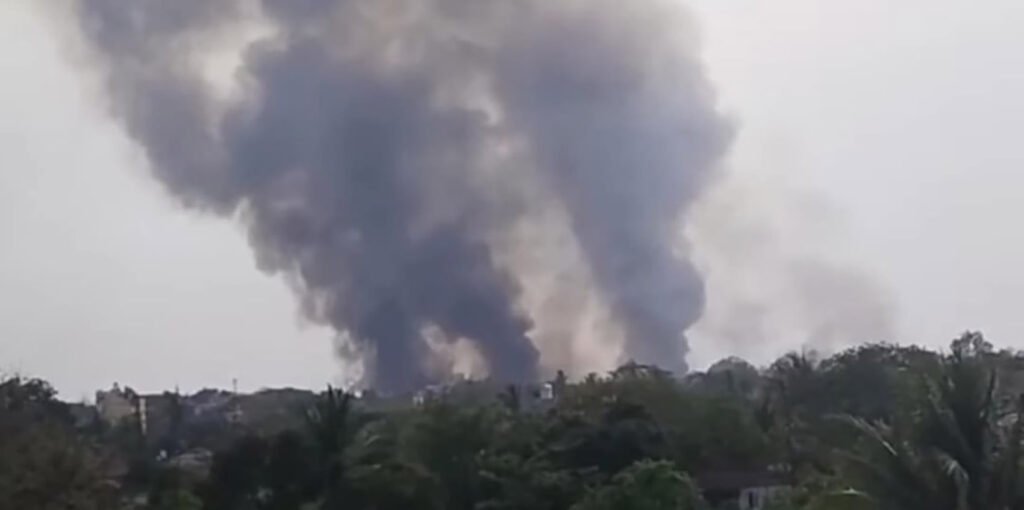

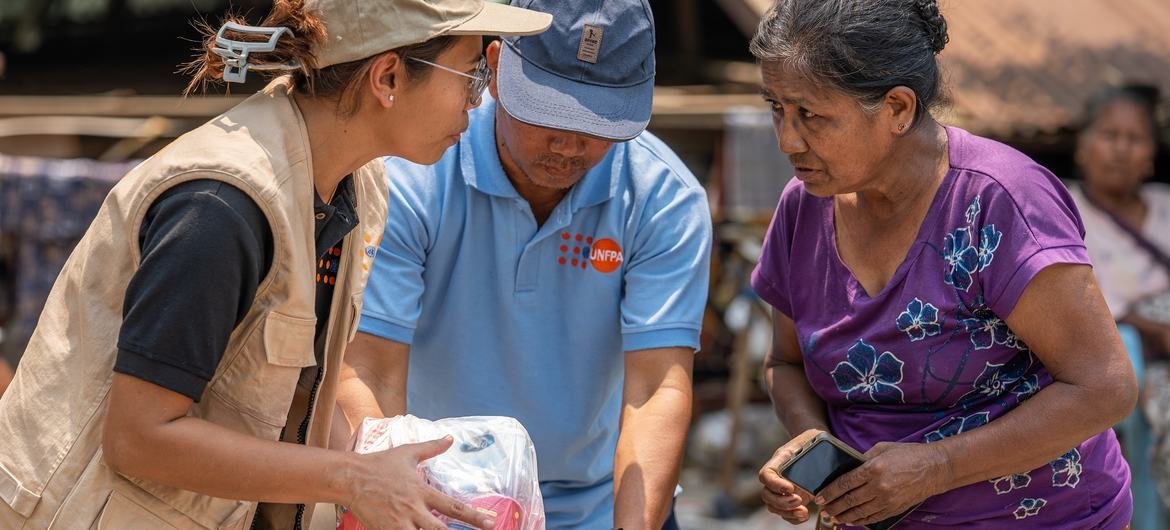

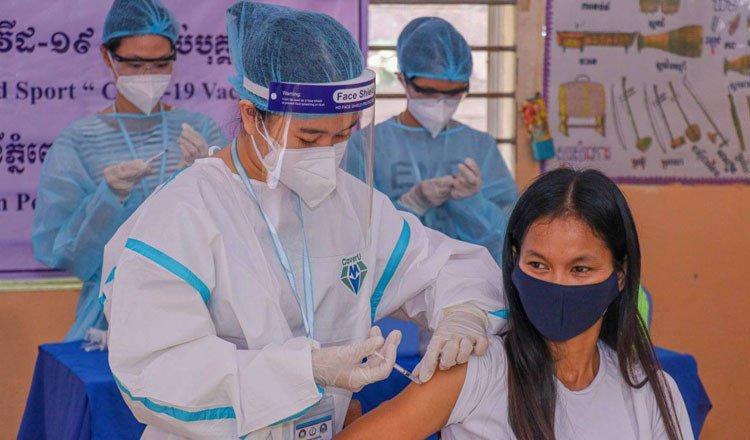



.jpg.72b06810548cbb40aca7255adba3e050.jpg)

